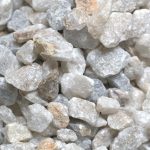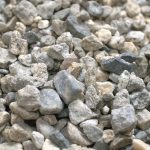Rocks, sand, and gravel are resourceful materials for hardscaping. They can be used together or interchangeably. Each is sourced separately and differs from the rest in composition, size, and shape. Let’s look at how each is made.
Rocks
Large rocks in a quarry are crushed into smaller pieces, screened, and stock piled into small, medium, and large sizes. After this, they are shipped to construction sites or companies that later re-distribute them.
Quarry operators and recyclers also crush bricks and concrete for further use. They are also screened and classified into stone dust, small, medium, large stones and various other sizes depending on its intended purpose.
Screening process is essential as different sizes of these crushed stones serve different purposes. Crushed stones are used to construct drainage systems, foundations, roads, road base and landscaping among other uses.
Gravel
Gravel can be easily confused for processed rocks but they are not the same. Gravel is naturally formed. As a result of being transported by water, it gains a rounded and smooth shape via the erosion process, while processed crushed rocks bear an angular shape with jagged edges.
Gravel is mainly used in its natural state but can also be crushed to have the suitable size for the designated work.
What are the different types of gravel?
Gravel can be classified into color or size. Classification by screening color is quite expensive and is rarely done. This leaves us with size as the main classifier. Here are the most common gravel types classified by size.
River rock
Varying in size from one to twelve inches or more in diameter, river rocks are often used for decorating walkways and driveways lining, edges, and flower beds.
Pea gravel
Smaller than the river rock, Pea gravel is commonly used where there is foot traffic. This includes pathways, a swimming pool, and walkways. Pea gravel as the name suggests is roughly the size of a pea 3/8” inch in diameter
Sand
Sand mainly results from soil erosion. Its granules are smaller than gravel but slightly bigger than silt. Sand is classified based on sources and components.
Quartz, often referred to as silicon dioxide is sand’s most common mineral. Sand appears in different colors depending on the formation and components. Most landscaping sands are white, red, and black. White sand originates from limestone erosion and has shells or coral fragments.
Black sand, usually from volcanic minerals is also composed of coral deposits and lava fragments. Red sand has a shade of orange. It is formed as a result of the iron oxide coating.
You can also get rare sands such as light brown sand, white-grey, or pink sand.
Commonly used sand types include:
- River sand, usually harvested from river banks. Its grains are round, fine, and polished due to water current action.
- Pit sand, normally dug out from the soil. Its porous, sharp, and angular. It is best suited for forming flower beds but can be screened for construction in some cases.
- Sea sand; is mostly used in play areas. It is obtained from seashores. It is rounded, fine, and polished and has a light brown shade.
Combining Sand and Gravel in Concrete
Roads, pathways, driveways, zen gardens, and general hardscaping require concrete. How effective the concrete largely depends on the ingredients applied and consistency. The four basic materials are water, sand, cement, and aggregate.
Landscaping experts mix four parts of gravel, two parts of sand, and one part cement to make strong concrete. This makes medium strength concrete. If you need it stronger, more cement added to the mixture will make the concrete stronger.
Regardless of the different materials used, knowing how they work determines how perfect the end product will be.
Summary
Rocks, gravel, and sand are non-renewable but will always be a staple in landscaping. They are essential for building pathways and roads. Knowing how each of these ingredients complements the other will ease the construction process and deliver great end products.



